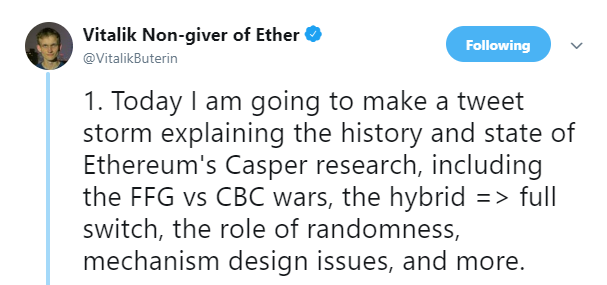Ethereum [ETH]’s Vitalik Buterin on a crusade – Sets out to educate the Twitterati on its Casper Research
![Ethereum [ETH]’s Vitalik Buterin on a crusade – Sets out to educate the Twitterati on its Casper Research](https://coinhub.news/img/5a/5a5edff50bef7282a675291d1db27853_730_522.webp)
On 15th August, Vitalik Buterin, Co-Founder of Ethereum, took the Twitter universe by storm as he set out to explain the history and developments of the Casper Research in a series of tweets totaling to an astounding 75 in number.
Vitalik started off by dutifully explaining what the development team has been up to in terms of the ‘Casper the Friendly Finality Gadget’ [By Vitalik] and the ‘Casper the Friendly GHOST’ [a.k.a. “correct-by-construction”].
He went on to outline the concept of Proof of Stake, the nothing at stake problem, the creation of Slasher and the correlation between the three. Buterin, in his first Tweet, said:

The Ethereum network at present uses a Proof of Work [PoW] based consensus algorithm wherein miners compete with each other to complete transactions on the network and get rewarded for the same. Earlier in May, the Ethereum team had reported that they would come up with an algorithm that would combine the Proof of Work and Proof of Stake algorithms to improve the Ethereum network and bring in a new version of code known as Casper.
The Casper Research according to Buterin began with the proof of stake research that started off in January 2014. The research led to the creation of an algorithm known as the Slasher which basically works on the principle that miners would lose their block reward if they attempt to sign blocks at the same height on two forks.
Buterin in another tweet stated that although Slasher is a ‘suboptimal’ algorithm, it has led to the formation of new and significant ideas like solving the ‘nothing at stake problem’ by administering penalties. According to the ‘nothing at stake’ theory, a miner loses nothing by signing each and every fork; consequently, their incentive would sign everywhere because it would not cost them anything.
The problem with this theory is that, when a fork happens, it doesn’t matter that the fork is incidental or if the fork is a malevolent attempt at rewriting block history as the transaction would ultimately be reversed. The optimal strategy for any miner would be to mine on every chain so that the miner gets the reward no matter which fork wins. As a consequence of this, miners would be able to send transactions to the other party in exchange for some digital goods which they would in turn receive. These miners would then begin a fork of the blockchain from a block preceding the transaction consequently sending money to themselves instead.
Buterin then went on to say:
“That said, the penalties that I used were very small, only canceling out signing rewards. Vlad Zamfir joined in mid-2014, and he quickly moved toward requiring validators to put down *deposits*, much larger in size than rewards, that could be taken away for misbehavior.”
According to Buterin, just canceling signing rewards is not enough of an incentive to solve the ‘nothing at stake problem’. Vlad Zamfir, whose expertise was crucial in the formation of Casper in his blog stated that adding deposits to Slasher would mean that the nothing at stake problem would officially be solved.














Article comments